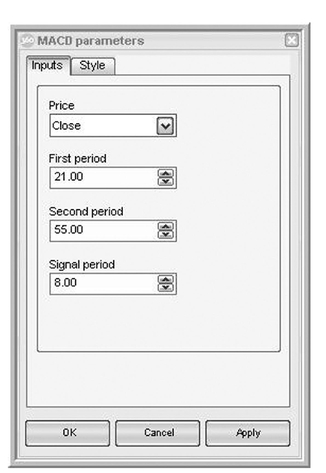MOVING AVERAGE CONVERGENCE DIVERGENCE (MACD)
Moving average convergence divergence, generally known as MACD (pronounced “mack dee”) is one of the most reliable and simple indicators in our toolbox. MACD is a trend-following momentum indicator, or oscillator, which shows the relationship between two moving averages of recent prices. An example is shown in Figure 1.1.
The MACD is often made up of three components:
1. MACD Line: The actual MACD line is calculated by subtracting a slow moving average (EMA) from a fast EMA. In our example we use the 21 as the fast EMA and the 55 as the slow EMA.
2. Signal Line: The signal line represents an EMA, not of price, but of the MACD. In this case we calculate the EMA of our MACD for the last eight bars.
3. Histogram: The MACD histogram is the difference between the MACD and its signal line.
MACD just might be the most popular indicator used by forex traders. That is why we recommend that you use it. However, be aware that MACD is often misused. Like any other technical indicator, you cannot rely on it for trades. It should be part of your entire trading planning process.
FIGURE 1.1 Moving Average Convergence Divergence (MACD)
Source: DealBook® 360 screen capture printed by permission. c 2008 by Global Forex Trading, Ada MI USA

How to Use MACD
There are three common scenarios to watch for:
1. Crossovers: When the MACD falls below ...
Get The FX Bootcamp Guide to Strategic and Tactical Forex Trading now with the O’Reilly learning platform.
O’Reilly members experience books, live events, courses curated by job role, and more from O’Reilly and nearly 200 top publishers.

